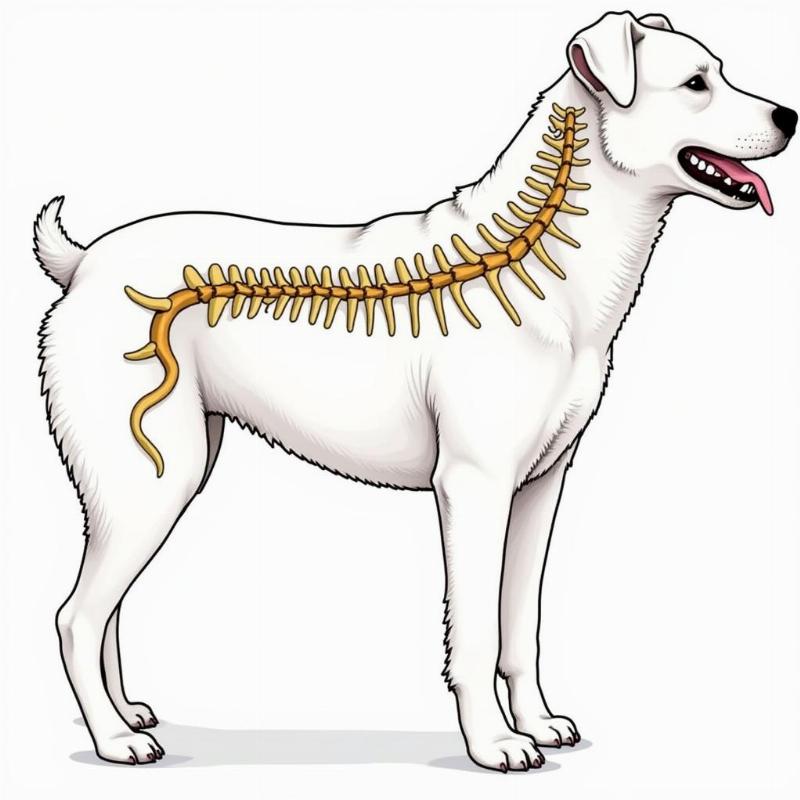Spinal cord tumors in dogs can be a devastating diagnosis. These tumors, abnormal growths within the spinal canal or the bones of the spine, can press on the spinal cord, leading to pain, weakness, and even paralysis. Understanding the causes, symptoms, diagnosis, and treatment options for spinal cord tumors is crucial for any dog owner. This guide will provide you with comprehensive information to help you navigate this challenging situation.
Understanding Spinal Cord Tumors
 Sơ đồ khối u tủy sống ở chó
Sơ đồ khối u tủy sống ở chó
Spinal cord tumors can be primary, originating within the spinal cord itself, or secondary, spreading from cancer elsewhere in the body (metastasis). Primary tumors are more common. Unfortunately, determining the exact cause of these tumors is often difficult. Some breeds, such as German Shepherds, Boxers, and Golden Retrievers, may have a slightly higher predisposition. Age is also a factor, with older dogs being more susceptible.
Recognizing the Signs
Symptoms vary depending on the tumor’s location, size, and growth rate. Early signs can be subtle, often mistaken for arthritis or other orthopedic issues. Be vigilant for any changes in your dog’s mobility or behavior.
- Pain: This is often the first and most noticeable sign. Your dog may yelp when touched, be reluctant to move, or show stiffness.
- Weakness: Noticeable weakness or paralysis in the legs can develop, often progressing over time.
- Incoordination: Your dog may stumble, appear clumsy, or have difficulty walking in a straight line.
- Loss of bladder or bowel control: This is a serious symptom and requires immediate veterinary attention.
- Changes in posture: A hunched back or an unusual gait can indicate spinal cord compression.
Diagnosing Spinal Cord Tumors
If you suspect your dog has a spinal cord tumor, a prompt veterinary examination is essential. The diagnosis process typically involves:
- Physical and Neurological Examination: Your vet will assess your dog’s reflexes, posture, and gait.
- Imaging: X-rays can reveal bony changes, while MRI or CT scans provide more detailed images of the spinal cord and surrounding tissues.
- Biopsy: Collecting a tissue sample for microscopic examination confirms the diagnosis and determines the tumor type. This can be obtained through surgery or a less invasive needle biopsy.
Treatment Options and Prognosis
Treatment depends on several factors, including the tumor type, location, and your dog’s overall health.
- Surgery: If the tumor is accessible, surgical removal may be the best option. However, complete removal isn’t always possible.
- Radiation Therapy: This uses high-energy rays to kill cancer cells and shrink the tumor, often used in conjunction with surgery.
- Chemotherapy: While less commonly used for spinal cord tumors, chemotherapy can help slow tumor growth and manage symptoms.
- Palliative Care: This focuses on managing pain and improving your dog’s quality of life, especially when curative treatment isn’t feasible.
The prognosis for dogs with spinal cord tumors varies considerably. Early diagnosis and aggressive treatment offer the best chance for a positive outcome.
Frequently Asked Questions
- How long can a dog live with a spinal cord tumor? The lifespan varies depending on the tumor type, location, and treatment response. Some dogs can live for months or even years with appropriate management.
- Are spinal cord tumors painful for dogs? Yes, spinal cord tumors often cause significant pain. Pain management is a crucial part of treatment.
- Can spinal cord tumors be cured in dogs? In some cases, surgical removal can be curative. However, many tumors are not completely removable, and recurrence is possible.
- What are the signs of a spinal cord tumor in a dog’s back legs? Weakness, paralysis, incoordination, dragging of the paws, and difficulty standing or walking are common signs.
- How much does it cost to treat a spinal cord tumor in a dog? The cost of treatment can vary significantly depending on the diagnostic tests, treatment options, and the veterinarian’s location.
- What are the alternative treatments for spinal cord tumors in dogs? Some dog owners explore alternative therapies such as acupuncture, herbal remedies, and chiropractic care for symptom management. Discuss these options with your veterinarian.
- What are the chances of a spinal cord tumor returning after surgery? The risk of recurrence depends on the tumor type and the extent of surgical removal.
Related Articles
Beautdogs.us is your premier resource for comprehensive dog care information. We offer expert advice on breed-specific needs, nutrition, health, and training. Whether you’re a new dog owner or a seasoned expert, Beautdogs.us is your trusted source for all things canine. Contact us at [email protected] or call us at +1 501-555-7529. Visit Beautdogs.us today for more helpful resources.